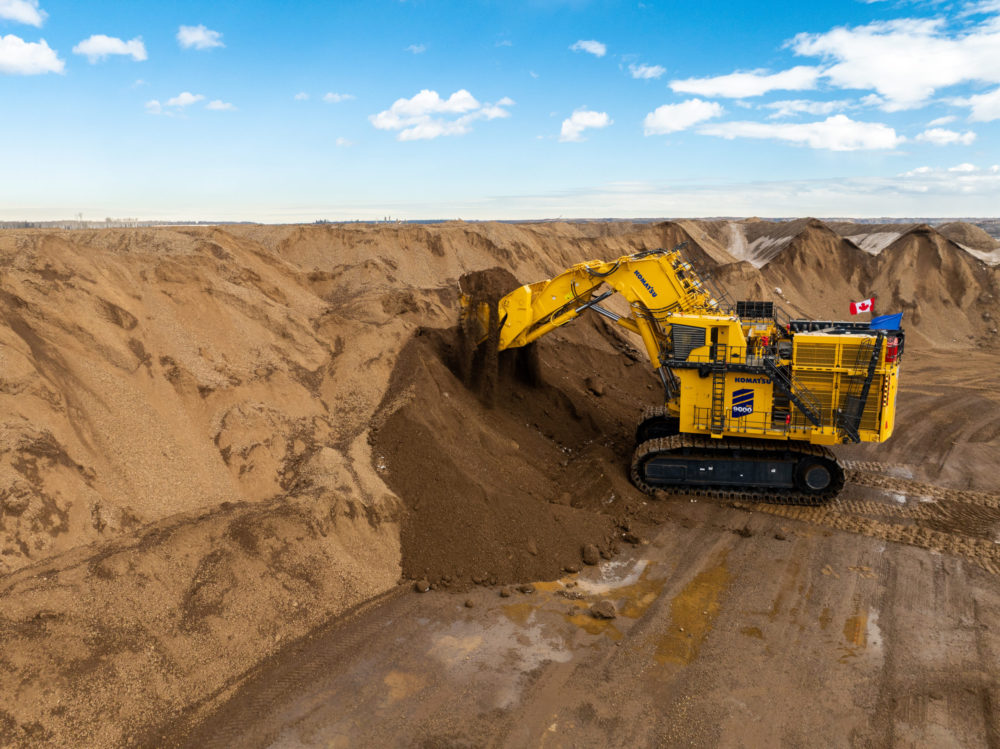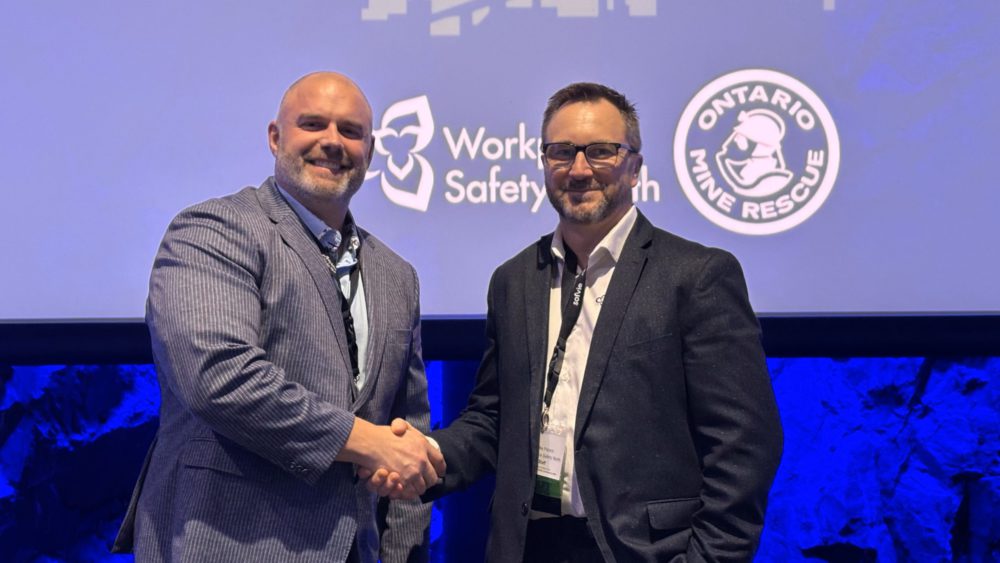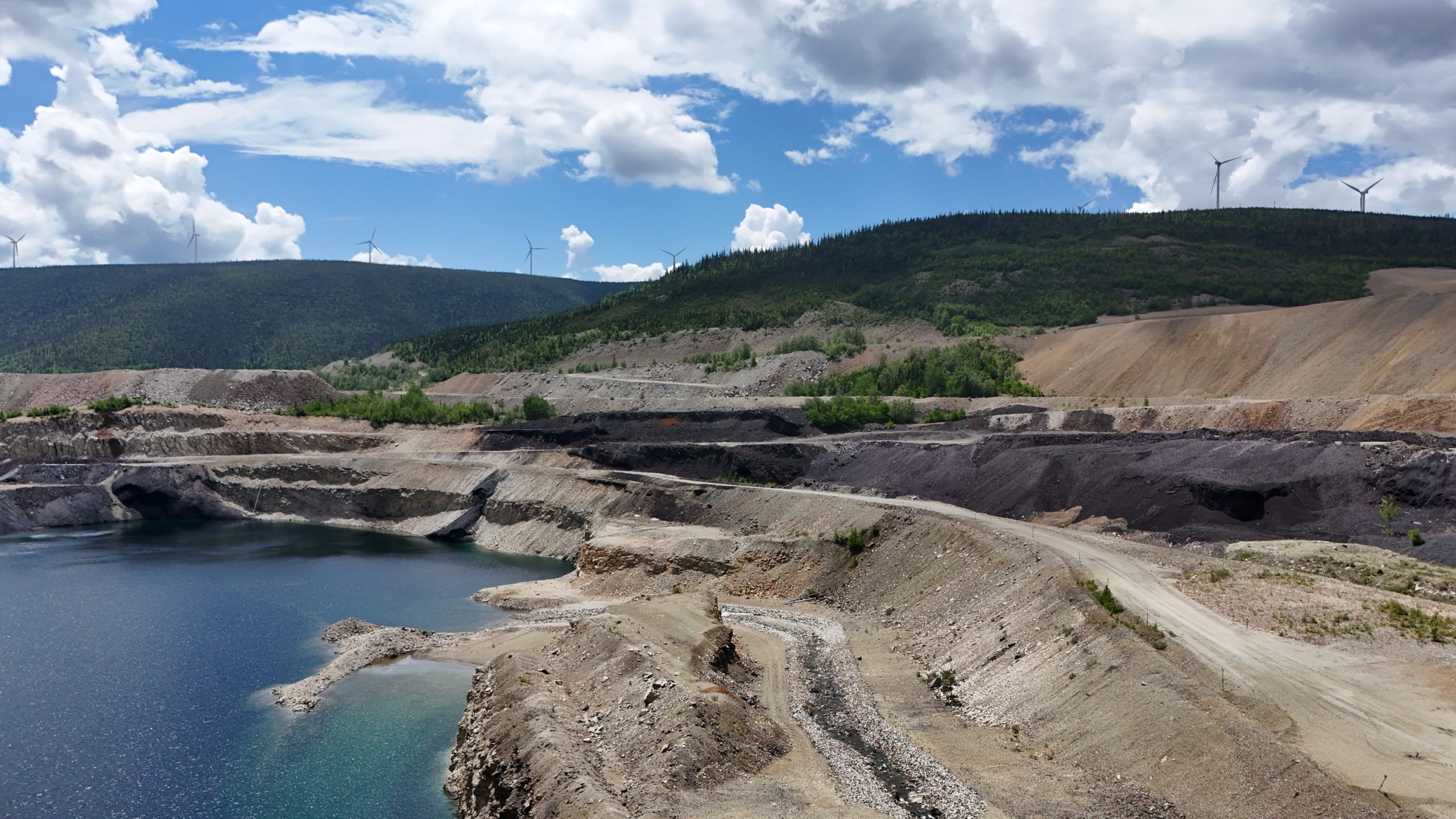Bethune potash mine feeds the future of K+S

New multi-billion dollar potash mine in Saskatchewan opens after five years of construction. Credi: K+S AK+S Aktiengesellschaft.
On May 2, with 700 guests attending and not an empty seat in the house, K+S Potash Canada (KSPC) celebrated the official opening of its Bethune potash mine – the first greenfield potash mine built in Saskatchewan in more than 40 years.
Sam Farris, vice-president and manager of operations, says the unforgettable event was very impressive – especially considering it was held in the maintenance garage and shop area. “I was told it felt like the Oscars,” he told CMJ in an interview a week after the event.

K+S CEO Norbert Steiner (centre), with Saskatchewan Premier Brad Wall
(left) and Dr. Ralf Bethke (right), chairman of the board of K+S. Credit: K+S Aktiengesellschaft.
More importantly, after nearly five years of construction, the event signalled that the project was entering a new phase.
“It felt like we’re really going into operation, and the construction phase will finally come to an end,” Farris recalls.
Farris, who joined K+S in mid-2011 and has helped build K+S Potash Canada from the ground up says it was a proud moment.
“K+S Potash Canada was a greenfield company, it didn’t exist until this project was approved so we had to start from the ground up,” he says. “From the time we hired our first operator until now, the difference is unbelievable. I think that really came to surface during the opening – it was a proud moment.”
K+S Group, a major supplier of salt and potash based in Kassel, Germany, acquired the former owner of the Legacy project, Potash One, in 2011. The name change to Bethune was unveiled at the opening ceremony reflecting Saskatchewan’s long-standing tradition of naming mines for the nearest community), and it has now become K+S Group’s first operating potash mine outside of Europe.
By the end of June, Bethune expects to produce its first tonne of marketable potash, and by the end of 2017, production capacity is expected to reach 2 million tonnes per year.
The solution mine, which is located 70 km northwest of Regina, will create more than 400 permanent jobs and have a mine life of more than 50 years.
“With our new location, we are taking a huge step forward in the internationalization of our potash business,” said Norbert Steiner, chairman of the board at K+S Aktiengesellschaft, in a release on May 2. “Bethune enables us to participate in future market growth, reduce our average production costs and strengthen our international competitiveness, which will benefit the entire K+S Group.”
Annual production will gradually grow from 2 million tonnes of potassium chloride (KCl) per year to 2.86 million tonnes per year by 2023. While potash prices have fallen, K+S – a company with a more than 125-year history – has a long term vision.
“You can’t build a potash mine for the near future – it’s not like the precious metals where you can mine a small deposit – get in, get out,” Farris says. “This is a long-term operation, we’re building it for at at least 50 years and the resource in Saskatchewan can easily support that. Long term, we’re very confident in the attractiveness of the potash market.”
Despite volatility in potash prices since about 2007, K+S expects the global potash market to continue to grow as the world population grows and people’s diets improve.
Raising the roof
As its design and project management partner at Bethune, K+S hired Amec Foster Wheeler to manage design and construction of the project. Managing such a large, complex project isn’t easy. At the peak of construction last year, Amec had about 3,000 people including sub-contractors working onsite and the company has put in more than 20 million hours of work.
“We have a fantastic safety record on this project, we went 10 million hours without a lost-time accident,” said Dave Lawson, Amec’s president, mining, in an interview in March.
Amec saved K+S time by embracing a modular approach to construction.
“We have been doing some pretty innovative things on the project with modularization – building things offsite and then shipping them to the site and installing them,” Lawson says. “By doing that, you save yourself a lot of time at site.”
In addition, Lawson notes that the company found ways to like concrete, pipes, and steel.
Because it was a greenfield site with no paved access road, with much of the construction taking place offsite then being shipped in, the site was largely open to the elements until 2015. While the project isn’t remote, it is about 20 km off of Highway 11.
“The weather is probably one of the biggest challenges on a project like this, until you’re closed in,” Farris says.
In 2013, the site had to deal with two “one in 100-year” rain events, Farris cites as one example.
“We had to shut the site down for two days – we didn’t even have a permanent drainage system in place at that time.”
Another setback came last July, when one of the process vessels in the processing plant fell, causing “consequential damage.”
Luckily, there were no significant injuries.
Labour market
In terms of labour, K+S benefited from good timing. When K+S’s supervisory board approved construction of the project in November 2011, there weren’t a lot of qualified people available on the operations side or the construction side.
But the downturn in oil and gas, and then in commodities opened up the labour market just in time. “Really if we had been even a year earlier we would have had a harder time finding construction labour for sure.”
Because it was a greenfield project, there wasn’t an opportunity to train new operators on existing equipment. Farris says the company did two things to get its operations labour force ready.
“First, we sent most of our process operators to Europe where they got exposure to some of our European mines that have similar technologies and processes,” he says. “And then we used a training simulator which really gave them hands-on experience with the PCS – the plant control system. It simulated a lot of the physics of the plant to give them a sense of how it would react control wise.”
The PCS allows operators to monitor and control all six main process areas of the mine, including the wellfield, the tank farm and utilities, the evaporation, wet end and dry end areas of the process plant and the storage and loadout area.
Solution mining
As a solution mine, the multi-billion dollar price tag to build Bethune was lower than it would have been for a conventional shaft mine. With the orebody located at 1,500 metres vertical depth, it’s also a quicker method to reach production.
Duane Gingrich, Amec’s president mining and metals Americas, notes that solution mines are pretty rare. “You need warmer temperatures to make it viable,” he says.
To develop production caverns, a number of wells are drilled from surface using directional drilling and spaced about 80 metres apart to a vertical depth of 1,500 metres and a casing is inserted.
Unheated water injected into the casings slowly dissolves salts (sodium chloride and potassium chloride) in a radial direction from each well until the two wells meet and become connected at depth. At that point, water can be injected into one well and brine returned from the other.
It takes about three years to develop a new cavern from the time it takes to build the drill pad site, drill the wells and extend infrastructure to the time the cavern is ready for production.
Once the cavern is ready for production, hot water is injected to dissolve potash and a KCl rich brine is returned to surface.
From there, the brine, which is near saturated in sodium chloride (the ore is roughly two-thirds sodium chloride and one-third potash) is brought up to full saturation and processed in the evaporation/ crystallization plant.
The brine is heated and concentrated by evaporators, then cooled with vacuum crystallizers and solid potash crystallizes out of the solution.
From there, Farris says it’s like any other potash mine – the potash is debrined, dried and in some cases compacted to meet customer size specifications.
For the full production capacity of 2 million tonnes per year, which is what K+S is aiming for by year’s end, 50-54 caverns need to be developed, Farris says. Roughly 36 should be ready this summer.
Cavern life varies from 10 to 20 years, depending on the mining method.
One way that K+S is reducing operating costs is through secondary mining.
“Once we bring in secondary mining that significantly reduces our water and energy intensity,” Farris says.
While primary mining is more energy intensive and requires hot water to dissolve the ore, secondary mining utilizes a brine loop set up between the cooling pond and secondary mining caverns, where sodium chloride-saturated brine is injected into the ground, Farris says.
“When it comes into contact with a nice high-grade potash ore like we have, it dissolves potassium chloride and redeposits sodium chloride back underground. The brine that comes out goes through our cooling pond, and as it cools, potassium chloride crystallizes and we recover that with dredges back to our process plant.”
Farris adds: “It’s a similar principle but it’s a totally different technology to produce potash than the evaporation/crystallization plant – waste heat from the crystallization/evaporation plant is used to heat that brine so the two work together to minimize our overall energy intensity.”
Water for primary mining is heated via waste heat from the evaporation process and evaporated water is recycled and reused to dissolve ore.
“We did a lot of work in the design of our evaporation and crystallization plant to recover condensates –and the water and energy that represents. We reuse the water in our mining process.”
In addition to its very modern and advanced PCS, the company is doing a lot around a modern maintenance strategy to prevent more expensive equipment failures down the line.
“It’s not that other potash operations don’t use predictive maintenance, because they do, but I would say it’s at the core of our maintenance philosophy – it’s a reliability based maintenance system,” Farris says.
“Our use of automation and integration of systems is really unique,” he adds. “Most potash mines have distributed control systems, we have one system, one method that was used site wide and even most of the vendor packages were integrated into that.”
Additional infrastructure
When you consider the infrastructure that had to be built at the greenfield site, it’s not surprising that development of the project took half a decade. Site infrastructure includes an administration building; an operations building that holds a central control room, process control infrastructure, process analytics lab and maintenance shop; a process plant and a brine pumping station.
The site also hosts two product storage warehouses – one that can hold 100,000 tonnes of fertilizer products and another that can hold 40,000 tonnes of industrial potash. The plant will produce two different fertilizer products, MOP (muriate of potash) dustfree and MOP granular, plus KCl 99 compacted, which is used in industrial applications.
It also has a rail loading facility and 14 km of industrial rail owned and operated by K+S. That infrastructure connects with 30 km of new Canadian Pacific rail that was put down through rural Saskatchewan to connect the mine to existing rail. Product from Bethune is shipped by rail to Pacific Coast Terminal’s bulk handling facility in Port Moody, B.C. which was upgraded by KSPC to handle high volumes of potash rail unloading and ship loading, and then shipped to customers mainly in South America and Asia.
Bright spot
Amid the oil and gas and mining downturns, Bethune is undoubtedly a bright spot for the Prairie economy.
Summing up the feelings of many Saskatchewan residents at the Bethune mine opening, Premier Brad Wall expressed enthusiasm over having a new, long-lived mine open in the province.
“We’re delighted to welcome a very good corporate citizen, K+S, back to Saskatchewan as it begins operations at a mine that will create more than 400 permanent jobs and generate taxes and royalties for years to come,” he said. “The Legacy project strengthens Saskatchewan’s position as the world’s leading potash producer and is another indicator the province’s diversified and resilient economy is weathering economic uncertainty.”





Comments